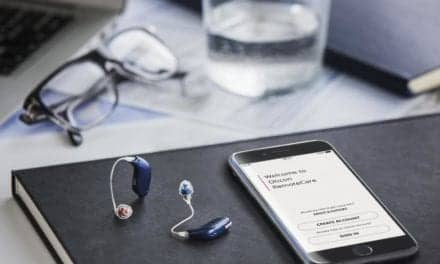Research | August 2015 Hearing Review
A look at TBI and considerations for hearing care professionals
Research suggests about 1.5 per 1,000 people are admitted to the hospital each year for traumatic brain injury (TBI), and hearing healthcare professionals are likely to have some of them as patients. TBI may result in hearing loss and vestibular and central auditory problems. This article offers a brief literature review on the subject with suggestions for hearing care professionals.
The statistics are impressive. Traumatic brain injury (TBI) is the leading cause of death and disability in the United States, with estimates suggesting that there are more than 1 million cases of head injury requiring hospitalization per year. In terms of all head injuries—regardless of all hospitalizations or severity of injury—the number may be as high as 3 million per year. Common causes of TBI include motor vehicle accidents, assaults, gunshot wounds, and blasts.
TBI displays an extremely varied spectrum of possible lesions and resulting potential disabilities (Table 1). The majority of TBI patients are likely to suffer some transient cognitive, motor, or sensory aberration, with many displaying residual physical, intellectual, or behavioral deficits. These deficits may be permanent, and some patients will never return to their previous level of independence and productivity. The cost of rehabilitation of traumatically brain injured patients is estimated to reach $25-30 billion annually.
Consequences of Traumatic Brain Injury |
| Neurological Impairment (motor, sensory, or autonomic) |
|
|
|
|
|
| Cognitive Impairments |
|
|
|
|
| Personality and Behavioral Changes |
|
|
|
|
| Common lifestyle consequences |
|
|
|
| Loss of autonomy and independence |
Epidemiology
Recent estimates suggest that there are about 1,500 people admitted to the hospital per 100,000 population per year for TBI. This figure probably underestimates the true incidence of TBI because of classification and diagnostic errors, as well as under-reporting of mild injury.
The incidence of TBI peaks in the age group 15-35 years, and is more common in males. Much of this gender difference is thought to be related to risk-taking behavior and is therefore potentially preventable. Among the elderly, the primary contributing factor for traumatic brain injury among adults ages 65+ is falls.
Pathogenesis
Traumatic brain injury is defined as damage to the brain resulting from external mechanical force, such as rapid acceleration or deceleration, impact, blast waves, or penetration from a projectile. The forces inflicted on the head produce a complex mixture of diffuse and focal lesions within the brain:
Focal injury: Because of the shape of the inner surface of the skull, focal injuries are more commonly seen in the frontal or temporal lobes, but may occur anywhere.
Diffuse injury: Diffuse injuries (often referred to as diffuse axonal injury, or DAI) are a generalized damage resulting in torn axonal fibers and supportive cells of the brain. DAI occurs as a result of stretching of neuronal fibers that interconnect different brain regions.
There is clear neuropathological evidence to suggest that the predominant pattern of injury in cerebral trauma is of a diffuse, nonspecific nature. When focal effects are present, they are typically superimposed on a more generalized pattern.
Other types of injuries considered diffuse include edema (swelling), contusions (bruising), hemorrhage (bleeding), all of which can produce compression effects which result in the mechanical distortions of cerebral structures.
Classification
There have been several attempts to develop a system of classification defining all types of head injury, but such classification attempts have possessed some limitations and lack of agreement because of the variety of ways in which the brain can be injured. Typically, most classification schemes attempt to establish the definition around some alteration in the level of consciousness.
TBI is usually classified at the time of injury based upon severity, and is categorized as mild, moderate, or severe. The severity of head injury is measured clinically using the Glasco Coma Scale (GCS), with scores ranging from 3 for a patient with no motor, verbal response, or eye opening, to 15 for a patient who is oriented, follows commands, and has spontaneous eye opening. Head injury is defined as mild when the GCS score is 13-15, moderate by a score of 9-12, and severe by a score of 3-8.
In mild cases of TBI, visible damage to the brain is rarely detectable with conventional neuroimaging, and a full clinical recovery is often possible for most patients, usually within 3 months of injury, and often sooner. In moderate-to-severe cases, visible damage is usually apparent and full clinical recovery may not be reached for at least 6-12 months post-injury, usually with some degree of cognitive, motor, or personality changes.
TBI and the Ear
TBI can cause a range of problems related to the ear, including hearing loss, vestibular effects, and central auditory problems.
Hearing loss. Because of the sudden and violent nature of the injury, TBI may cause concurrent damage to the auditory pathway. Damage can occur at any point within auditory pathway, from the outer ear to the cortex, which can result in a variety of complex symptoms.
Impairment due to trauma can produce conductive and sensorineural hearing loss, central auditory processing deficits, vestibular impairments, and tinnitus. The tympanic membrane, middle ear, and cochlea are the most common sites of peripheral injury as they are often directly in the line of trauma. Disruption of the oval and the round window can occur, as can displacement of the basilar membrane. The hair cells are the most vulnerable elements of the cochlea and, when damaged, can produce sensorineural hearing loss and tinnitus.
Clinical and experimental studies have shown that there are numerous sites of pathology ranging from TM perforation, ossicular discontinuity, degeneration of the organ of corti, and ischemia of the 8th cranial nerve.
Vestibular effects. Dizziness is thought to occur in 40-60% of individuals with traumatic brain injury. It is usually of peripheral as opposed to central origin. Most common causes include labyrinthine concussion or benign postural positional vertigo (BPPV), which is due to the dislodgement of calcium carbonate crystals from sensitive nerve endings at the macula of the utricle. Less common causes of labyrinthine injury include perilymphatic fistula resulting from the rupturing of the oval or round window membrane. Symptoms may include vertigo, tinnitus, hearing loss, chronic nausea, and exertion headache.
Central effects. The effects of damage to the central auditory system have not been systematically examined in humans, but animal studies have revealed much about the architecture of the system. The shearing or the stretching forces from trauma can disrupt the parallel organization of the brainstem and reduce the ability to localize sound or to make the minute frequency and temporal distinctions in the presence of competing stimuli. This reduction in binaural processing can undermine the ability of the auditory system to distinguish between multiple sound sources or to maintain speech recognition ability in the presence of back ground noise.
In summary, the most common otological complaints immediately following head trauma are otalgia, tinnitus, aural fullness, dizziness, loudness sensitivity, distorted hearing, and hearing impairment. Hearing loss may improve following the period of traumatic exposure, but in other cases it may persist or progress.
The underlying symptoms of vestibular, peripheral, and central auditory damage can overlap those of other conditions such as post-traumatic stress disorder (PTSD), concussion, and mild TBI. These deficits are particularly challenging in the TBI population, as symptoms can be mistaken for PTSD, mental health issues, and cognitive deficits.
Discussion
Patients with TBI present a distinctive and challenging population for the hearing healthcare practitioner. In addition to hearing loss, patients endure years of disability, as TBI often prevents a return to work, disrupts family relations, and causes increased social isolation, mood disorders, and even suicide. The variety of symptoms associated with the condition can include headaches, seizures, motor disturbances, and insomnia, as well as changes in cognition, memory, and speech.
The treatment and rehabilitation of auditory and vestibular injury associated with TBI will require a collaborative approach between otolaryngology, audiology, speech-language pathology, neuropsychology, mental health, and physical and occupational therapy. Audiologists and allied professionals should be prepared to modify treatment protocols, incorporate new disciplines in the treatment process, and work in consultation with allied health professionals.
Those patients with cognitive impairments will require additional time and attention in order to maximize the benefits of rehabilitation. Behavioral issues are also common in patients with TBI, and TBI can precipitate problems that require treatments involving emotional management and impulse control.
Mood disorders and psychiatric disturbances are common after traumatic brain injury and may include depression, anxiety, bipolar, psychosis, obsessive-compulsive disorder, and PTSD. In such cases, referral for psychotherapy and medical management would certainly be indicated, as the majority of these patients will benefit from a combined multidisciplinary approach.
References
-
Tun C, Hogan A, Fitzharris K. Hearing and vestibular dysfunction caused by blast injuries and traumatic Brain Injuries. Hear Jour. 2009:62(11):24-26.
-
Bigler ED. Traumatic Brain Injury: Mechanisms of Damage, Assessment, Intervention, and Outcome. Austin, Tex: Pro-Ed;1990:13-20.
-
Koshimori Y, Johns K, Green R. A guide for hearing healthcare providers to characteristics of traumatic brain injury. Hear Jour. 2009: 62(11):17-23.
-
Ylvisaker M, Turkstra LS, Coelho C. Behavioral and social interventions for individuals with traumatic brain injury: A summary of the research with clinical applications. Sem Speech Lang. 2005;26(4):256-267.
-
Khan F, Baguley IJ, Cameron D, Rehabilitation after traumatic brain injury. Rehab Med. 2003;178(17): 290-295.
-
Fausti SA. Auditory and Vestibular Dysfunction Associated with Blast-Related Truamatic Brain Injury. J Rehab Res Devel. 2009;46(6):800-809.
-
Kushner D, Mild traumatic brain injury: Toward understanding manifestations and treatment. Archi Intern Med. 1998;158(15):1617-1624.
-
Oleksiak M, Smith BM, St Andre JR, Caughlan CM, Steiner M. Audiological issues and hearing loss among veterans with mild traumatic brain injury. J Rehab Res Devel. 2012;49(7):995-1004.
-
Lew HL, Jerger JF, Guillory SB, Henry JA. Auditory dysfunction in traumatic brain injury. J Rehab Res Devel. 2007;44(7):921-928.
-
Scherer M, Schubert MC. Traumatic brain injury and vestibular pathology as a comorbidity after blast exposure. Phys Therapy. 2009;89(9):980-992.
-
Luethcke CA, Bryan CJ, Morrow CE, Isler WC. Comparison of concussive symptoms, cognitive performance, and psychological symptoms between acute blast versus nonblast-induced traumatic brain injury. J Intl Neuropsychol Soc. 2011;17:36-45.
-
Myers PJ, Wilmington DJ, Gallun FJ, Henry JA, Fausti SA. Hearing impairment and traumatic brain injury among soldiers: Special considerations for the audiologist. Sem Hearing. 2009;30(1):5-22.

Correspondence can be addressed to: [email protected]
Original citation for this article: Chiasson, CR. Traumatic Brain Injury (TBI): A Primer for the Hearing Healthcare Practitioner. Hearing Review. 2015;22(8):14.?






I experienced a fall from a standing position back ward with blood coming from both my ears. Hit my head on the asphalt. Was unconscious for a brief period . My wife found me on my back. Hospitalized for 1 week then 1 week of recovery before released to home. Significant loss of hearing continues after 2 months. Both eardrums are intact. Have acquired hearing aids to restore my sensitivity but without them am down about 50% of normal. Balance is slowly recovering. coordination lacks a bit. Tinnitus is about the same. At least I remain fairly active 74 years.
What can I do to regain my normal hearing? Insurance is fair and finances are adequate.
Glen
My guess is that you have a sensorineural hearing loss related to both your age and possibly your accident, and you will need your hearing aids to hear adequately. You should, of course, see a good audiologist and/or ENT to see what your options are.
Has anybody else had audible hallucinations after there’s
I suffered a nearly fatal TBI in 2011. Despite my miraculous and almost complete recovery, I continue to suffer from severe hearing loss on one side. I am interested in learning all I can about how to recover my hearing. I am an athletic 43 year old woman with a positive attitude intent on regaining my hearing.
I am a senior scientist at N2 Biomedical, working with cerebral oximetry. DOD just released a funding opportunity entitled “Hearing and Balance Research Award” and we plan to respond to this solicitation but need a collaborator in the area of audiology/otolaryngology. If any readers are interested in such collaboration, I would be glad to send you more details of the solicitation as well as our thinking in regard to the use of cerebral oximetry for this research.
Thank you in advance for your cooperation.
Best regards,
Kurt Linden
So TBI can cause hearing amplification?
Hi nicole . I had a tbi and 2 surgeries.-a burr hole evacuation and a craniotomty 6 weeks ago. Im sorry I do not have inforrmation for you just to say I suffer some days from sound amplification, especially things like motors, not nice. If there is more info re this phenomenon I would loveto hve it. Msggie